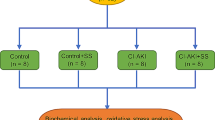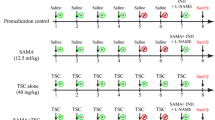Abstract
Objective
To study the prevention effect of salidroside on contrast-induced-nephropathy (CIN) and its underlying mechanism.
Methods
A total of 24 Wistar rats were randomly divided into 4 groups with 6 in each group. Rats were firstly administrated with normal saline (control and model groups), N-acetylcysteine (NAC, NAC group) and salidroside (salidroside group) for 7 days before model establishment in each group, respectively. Histopathological analysis was performed by periodic acid-Schiff (PAS) staining. Oxidative stress related parameters including superoxide dismutase (SOD) and methane dicarboxylic aldehyde (MDA), nitric oxide (NO), angiotensin II (Ang II), 8-hydroxy-2′-deoxyguanosine (8-OHdG), mRNA and protein levels of endothelial nitric oxide synthase (eNOS), and nitric oxide synthase (NOS) activity were measured.
Results
Compared with the control group, the levels of MDA, Ang II and 8-OHdG were all significantly increased and levels of SOD, NO, and eNOS mRNA and protein were decreased significantly in the model group (P<0.05). Meanwhile, the NOS activity was also significantly decreased in the model group (P<0.05). In addition, the levels of these parameters were all improved in the NAC (P<0.05) and salidroside groups and no significant different was found between these two groups (P>0.05).
Conclusion
Salidroside can be the potential substitute of NAC to prevent CIN. The underlying mechanism may be associated with oxidative stress damage caused by contrast agents.
Similar content being viewed by others
References
Lekston A, Kurek A, Tynior B. Impaired renal function in acute myocardial infarction. Cardiol J 2009;16:400–406.
Leveridge MJ, Bostrom PJ, Koulouris G, Finelli A, Lawrentschuk N. Imaging renal cell carcinoma with ultrasonography, CT and MRI. Nature Rev Urol 2010;7:311–325.
Ari E, Yilmaz Y, Kedrah AE, Alahdab Y, Cakalagaoglu F, Arikan H, et al. Protective effect of the vasopressin agonist terlipressin in a rat model of contrast-induced nephropathy. Am J Nephrol 2011;33:269–276.
Bell RM, Rear R, Cunningham J, Dawnay A, Yellon DM. Effect of remote ischemic conditioning on contrast-induced nephropathy in patients undergoing elective coronary angiography (ERICCIN): rationale and study design of a randomised single-centre, double-blind placebo-controlled trial. Clin Res Cardiol 2014;103:203–209.
Pflueger A, Abramowitz D, Calvin AD. Role of oxidative stress in contrast-induced acute kidney injury in diabetes mellitus. Med Sci Monit 2009;15:RA125–RA136.
Persson PB, Hansell P, Liss P. Pathophysiology of contrast medium-induced nephropathy. Kidney Intern 2005;68:14–22.
Wong PCY, Li Z, Guo J, Zhang A. Pathophysiology of contrast-induced nephropathy. Intern J Cardiol 2012;158:186–192.
Wu M, Hsiang H, Wong C, Yao M, Li Y, Hsiang C. et al. The effectiveness of N-acetylcysteine in preventing contrast-induced nephropathy in patients undergoing contrast-enhanced computed tomography: a metaanalysis of randomized controlled trials. Intern Urol Nephrol 2013;45:1309–1318.
Sun ZK, Fu Q, Cao LX, Jin W, Cheng LL, Li Z. Intravenous N-acetylcysteine for prevention of contrast-induced nephropathy: a meta-analysis of randomized, controlled trials. PloS One 2013;8:e55124.
Brown R, Gerbarg P, Ramazanov Z. Rhodiola rosea; a phytomedicinal overview. Herbal Gram 2002:56:40–52.
Perfumi M, Mattioli L. Adaptogenic and central nervous system effects of single doses of 3% rosavin and 1% salidroside Rhodiola rosea L. extract in mice. Phytother Res 2007;21:37–43.
Jafari M, Felgner JS, Bussel II, Hutchili T, Khodayari B, Rose MR, et al. Rhodiola: a promising anti-aging Chinese herb. Rejuvenat Res 2007;10:587–602.
Yu P, Hu C, Meehan EJ, Chen L. X-ray crystal structure and antioxidant activity of salidroside, a phenylethanoid glycoside. Chem Biodiv 2007;4:508–513.
Li FL, Tang H, Xiao F, Gong JL, Peng Y, Meng XL. Protective effect of salidroside from Rhodiolae Radix on diabetes-induced oxidative stress in mice. Molecules 2011;16:9912–9924.
Ari E, Yilmaz Y, Kedrah AE, Alahdab Y, Cakalagaoglu F, Arikan H, et al. Protective effect of the vasopressin agonist terlipressin in a rat model of contrast-induced nephropathy. Am J Nephrol 2011;33:269–276.
Ahmad A, Mondello S, Di Paola R, Mazzon E, Esposito E, Catania MA, et al. Protective effect of apocynin, a NADPH-oxidase inhibitor, against contrast-induced nephropathy in the diabetic rats: a comparison with n-acetylcysteine. Eur J Pharmacol 2012;674:397–406.
Riley DP. Functional mimics of superoxide dismutase enzymes as therapeutic agents. Chem Rev 1999;99:2573–2588.
Mateos R, Lecumberri E, Ramos S, Goya L, Bravo L. Determination of malondialdehyde (MDA) by high-performance liquid chromatography in serum and liver as a biomarker for oxidative stress: application to a rat model for hypercholesterolemia and evaluation of the effect of diets rich in phenolic antioxidants from fruits. J Chromatogr B 2005;827:76–82.
Wu LL, Chiou CC, Chang PY, Wu JT. Urinary 8-OHdG: a marker of oxidative stress to DNA and a risk factor for cancer, atherosclerosis and diabetics. Clin Chim Acta 2004;339:1–9.
Drechsel DA, Estévez AG, Barbeito L, Beckman JS. Nitric oxide-mediated oxidative damage and the progressive demise of motor neurons in ALS. Neurotox Res 2012;22:251–264.
Chrissobolis S, Banfi B, Sobey CG, Faraci FM. Role of Nox isoforms in angiotensin II-induced oxidative stress and endothelial dysfunction in brain. J Appl Physiol 2012;113:184–191.
Pannu N, Wiebe N, Tonelli M, Alberta Kidney Disease Network. Prophylaxis strategies for contrast-induced nephropathy. JAMA 2006;295:2765–2779.
Yang DP, Yang DW. Role of intracellular Ca2+ and Na+/Ca2+ exchanger in the pathogenesis of contrast-induced acute kidney injury. Biomed Res Int 2013;2013:678456.
Nikolsky E, Aymong ED, Dangas G, Mehran R. Radiocontrast nephropathy: identifying the high-risk patient and the implications of exacerbating renal function. Rev Cardiovasc Med 2003;4Suppl 1:S7–S14.
Ježek P, Hlavatá L. Mitochondria in homeostasis of reactive oxygen species in cell, tissues, and organism. Internat J Biochem Cell Biol 2005;37:2478–2503.
Salvayre R, Auge N, Benoist H, Negre-Salvayre A. Oxidized low-density lipoprotein-induced apoptosis. Biochim Biophys Acta 2002;1585:213–221.
Mundel P, Shankland SJ. Podocyte biology and response to injury. J Am Soc Nephrol 2002;13:3005–3015.
Wagner MC, Rhodes G, Wang E, Pruthi V, Arif E, Saleem MA, et al. Ischemic injury to kidney induces glomerular podocyte effacement and dissociation of slit diaphragm proteins Neph1 and ZO-1. J Biologic Chem 2008;283:35579–35589.
Zhao XY, Jin LH, Wang DJ, Xu B, Zhang W, Luo ZL. Salidroside inhibits endogenous hydrogen peroxide induced cytotoxicity of endothelial cells. Adv Mater Res 2013;750:1529–1532.
Yuan Y, Wu SJ, Liu X, Zhang LL. Antioxidant effect of salidroside and its protective effect against furan-induced hepatocyte damage in mice. Food Funct 2013;4:763–769.
Zhang XY, Hu CG, Yao JL. Tetraploidization of diploid Dioscorea results in activation of the antioxidant defense system and increased heat tolerance. J Plant Physiol 2010;167:88–94.
Author information
Authors and Affiliations
Corresponding author
Additional information
Supported by the National Nature Science Foundation of China (No. 81273968 and No. 81471027), and Ministerial Project of the National Working Commission on Aging (No. QLB2014W002)
Rights and permissions
About this article
Cite this article
Xing, Y., Wei, Rb., Tang, L. et al. Protective effect of salidroside on contrast-induced nephropathy in comparison with N-acetylcysteine and its underlying mechanism. Chin. J. Integr. Med. 21, 266–273 (2015). https://doi.org/10.1007/s11655-015-2137-y
Received:
Published:
Issue Date:
DOI: https://doi.org/10.1007/s11655-015-2137-y




